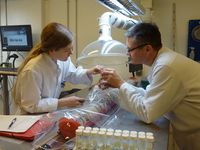Transport parameters and contaminant data
| Highlights |
|---|
|
try it out |
Transport parametersAdvective transport happens mainly with the groundwater flow. However, to describe the transport of a substance in a fractured limestone aquifer properly, additional parameters are required. Important transport parameters that influence the migration of a substance are
Tracer tests are very useful to analyze the transport behavior in a limestone aquifer. Different types of tracer tests can be distinguished
In the limestone project, a forced-gradient tracer test with several injection wells and a central pumping well for tracer monitoring was conducted. Details are described in the following report: Furthermore, measurements from core material can be used to determine the porosity and hydraulic conductivity of a limestone sample, for example using gas permeameter and porosimeter (Poroperm test). Contaminant dataDifferent sampling and monitoring techniques to determine the depth-discrete contaminant distribution in boreholes have been developed. Depth-discrete sampling is important, since due to a very heterogeneous nature of the aquifer, the concentration can vary strongly over depth. For the planning of a site remediation it is important to know the vertical extent of the contamination, so the remediation system can be planned targeted on the high concentration zones. One way to obtain depth-discrete concentrations is to analyze small samples from borehole cores for the sorbed contaminant concentration. An example is shown in Figure... The following list gives an overview of some useful sampling methods in wells in limestone aquifers:
The following ones require open (unscreened) boreholes:
The following report gives a comparison of different sampling methods. Integral pump tests can be used to quantify the contaminant mass discharge through a control plane. |
